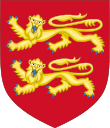
Back Huis van Normandië Afrikaans أسرة نورماندي Arabic Normand sülaləsi Azerbaijani Нармандская дынастыя Byelorussian Нормандска династия Bulgarian Normanska dinastija BS Dinastia normanda Catalan Normanská dynastie Czech Huset Normandiet Danish Rolloniden German
This article needs additional citations for verification. (October 2018) |
| House of Normandy | |
|---|---|
 Arms of the Duchy of Normandy[nb 1] | |
| Country | |
| Founded | 911 |
| Founder | Rollo |
| Final ruler | Henry I of England or Matilda (disputed) |
| Titles | |
| Dissolution | 1167 |
| Deposition | 1135 |
| Cadet branches | Illegitimate lines:
|
| |
The House of Normandy (Norman: Maison de Nouormandie [mɛ.zɔ̃ d̪e nɔʁ.mɛnde]) was a noble family originating from the Duchy of Normandy. The House of Normandy's lineage began with the Scandinavian Rollo who founded the Duchy of Normandy in 911.[1]
The House of Normandy includes members who were dukes of Normandy, counts of Rouen, as well as kings of England following the Norman conquest of England. It lasted until Stephen of the French House of Blois seized the Duchy of Normandy in 1135. The house emerged from the union between the Viking Rollo[2] (first ruler of Normandy) and Poppa of Bayeux,[3] a West Frankish noblewoman. William the Conqueror[4] and his heirs down through 1135 were members of this dynasty.
After that it was disputed between William's grandchildren, Matilda, whose husband Geoffrey[5] was the founder of the House of Plantagenet, and Stephen of the House of Blois (or Blesevin dynasty).[6]
The Norman counts of Rouen were:
- Rollo, 911–927
- William Longsword, 927–942
The Norman dukes of Normandy were:
- Richard I, 942–996 [7]
- Richard II, 996–1027 [8]
- Richard III, 1026–1027 [9]
- Robert I, 1027–1035 [10]
- William, 1035–1066 (became King of England as William the Conqueror)
The Norman monarchs of England and Normandy were:
- William the Conqueror, 1066–1087
- William II, 1087–1100 (not Duke of Normandy) [11]
- Robert II, 1087–1106 (not King of England) [12]
- Henry I, 1100–1135; 1106–1135 [13]
- William Adelin, 1120 (not King of England) [14]
- Matilda, 1135–1153 (disputed)[15]
- Stephen (non-agnatic; a member of the House of Blois), 1135–1154 [16]
Norman Count of Flanders:
- William Clito (r. 1127–1128), son of Robert Curthose, great-grandson of Baldwin V, designated by Louis VI of France[17]
Richard I had a daughter, Emma of Normandy, who was Queen consort through her two marriages to Æthelred the Unready and Cnut the Great.
- ^ "Rollo | duke of Normandy | Britannica". 3 May 2021. Archived from the original on 3 May 2021. Retrieved 26 October 2024.
- ^ "Norman | people | Britannica". www.britannica.com. Retrieved 7 December 2021.
- ^ "Poppa". fasg.org. Retrieved 7 December 2021.
- ^ Ciara.Berry (12 January 2016). "Royal Archives". The Royal Family. Retrieved 7 December 2021.
- ^ "Queen Matilda, Empress Maud and the Civil War with King Stephen". Historic UK. Retrieved 4 May 2022.
- ^ "Your guide to the Anarchy, the bloody battle between Stephen and Matilda". HistoryExtra. Retrieved 7 December 2021.
- ^ McNair, Fraser (2015). "The politics of being Norman in the reign of Richard the Fearless, Duke of Normandy (r. 942–996)". Early Medieval Europe. 23 (3): 308–328. doi:10.1111/emed.12106. ISSN 1468-0254. S2CID 153508365.
- ^ "Richard II | duke of Normandy | Britannica". www.britannica.com. Retrieved 7 December 2021.
- ^ "Richard III | duke of Normandy | Britannica". www.britannica.com. Retrieved 7 December 2021.
- ^ "Collections Online | British Museum". www.britishmuseum.org. Retrieved 7 December 2021.
- ^ Ciara.Berry (12 January 2016). "William II (Known as William Rufus) (r. 1087–1100)". The Royal Family. Retrieved 7 December 2021.
- ^ "Collections Online | British Museum". www.britishmuseum.org. Retrieved 7 December 2021.
- ^ Ciara.Berry (12 January 2016). "Henry I 'Beauclerc' (r. 1100–1135)". The Royal Family. Retrieved 7 December 2021.
- ^ "The lost prince whose death tipped England towards civil war". Royal Central. 25 November 2020. Retrieved 7 December 2021.
- ^ Matilda's inheritance was usurped by her cousin Stephen of England in 1135. She recovered Normandy, but ruled in England only in 1141 as Lady of the English. However, Matilda maintained her dynastic rights until she abdicated them in favour of her son Henry II of England in 1153 following the Treaty of Wallingford.
- ^ "BBC – History – King Stephen". www.bbc.co.uk. Retrieved 7 December 2021.
- ^ "William Clito | count of Flanders | Britannica". www.britannica.com. Retrieved 7 December 2021.